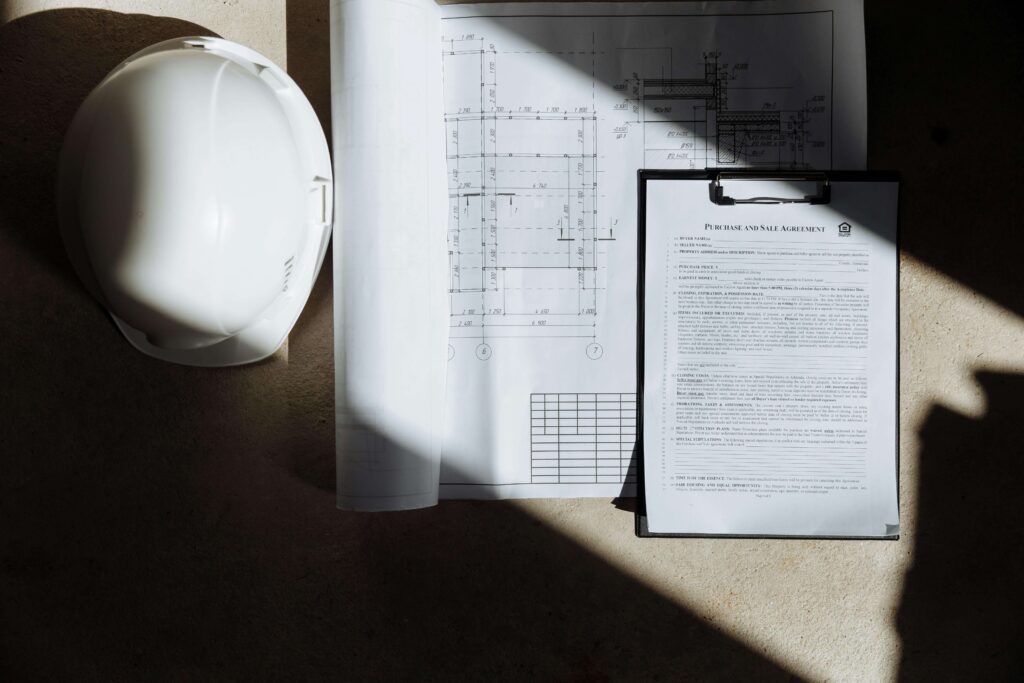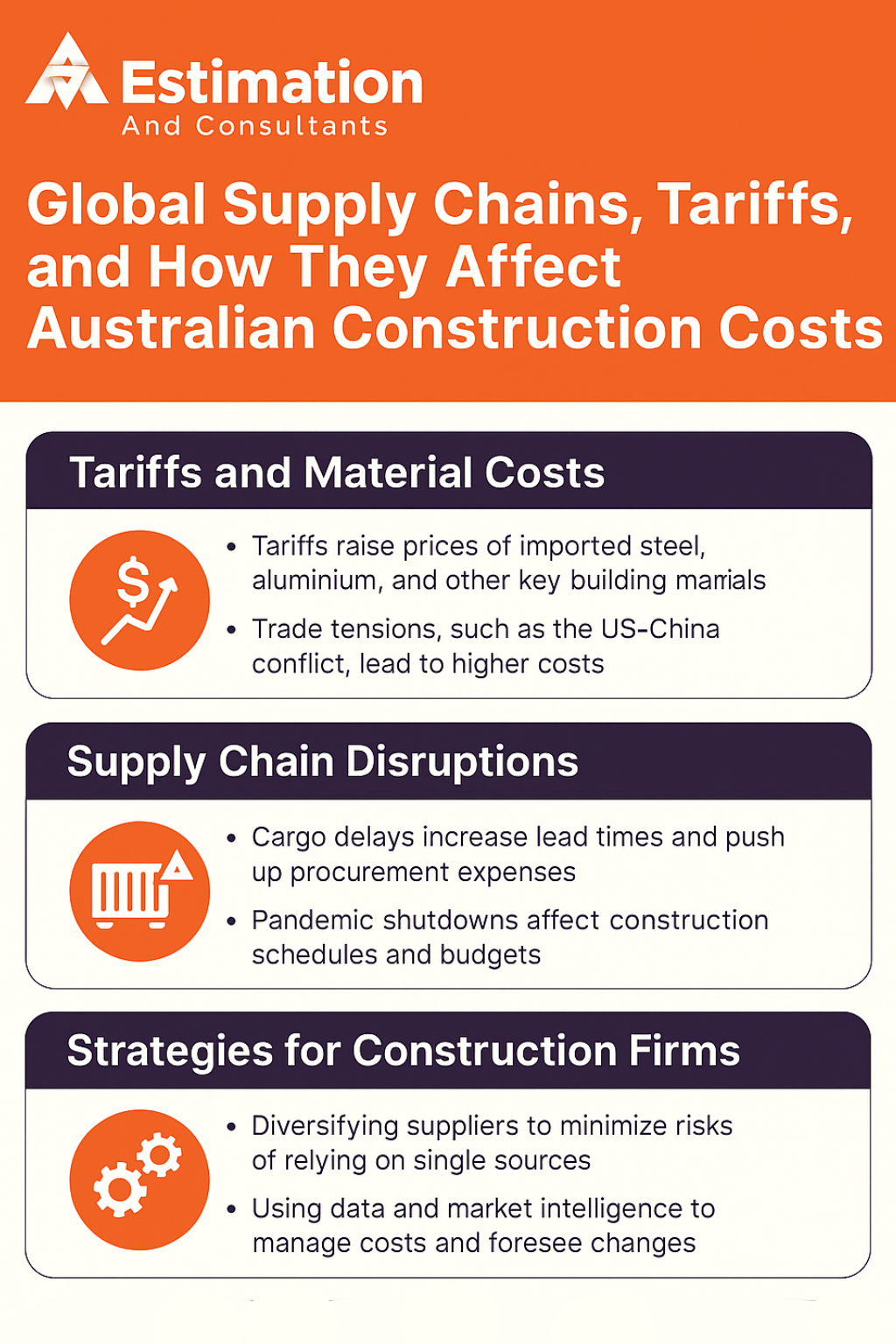Australia’s construction industry is deeply connected to global supply chains. From steel to timber, the materials that shape our skylines often travel across continents before reaching a project site. Any shift in these supply networks—whether caused by tariffs, trade disputes, or transport delays—can directly influence Australian construction costs.

Tariff effects don’t just impact import prices; they can also trigger wider cost escalation trends across the construction industry. When suppliers face higher expenses, those increases often flow through to builders, developers, and ultimately, property owners. Understanding these global trade impacts and their economic implications is essential for managing budgets, safeguarding profitability, and maintaining steady project delivery in a competitive market.
Understanding Tariffs and Their Role in the Construction Cost Equation
What Are Tariffs and How They Work
Tariffs are import taxes or trade duties placed on goods moving across borders. In construction cost estimating, they often apply to steel, timber, and other essential materials. These trade barriers increase costs for Australian projects, influencing contracts, governance decisions, and the overall flow of international trade.
The US-China Trade War and Australian Material Prices
The US-China trade war reshaped material costs worldwide. Reduced Chinese exports, trade redirection, and ripple effects in supply chains pushed up prices for steel and aluminium in Australia. For suppliers and contractors, these global trade conflicts have meant tighter margins and more complex planning for material import price impacts.
Supply Chain Disruptions in the Construction Industry
Causes of Supply Chain Disruption
Australia’s construction sector has faced ongoing supply chain disruptions that slow projects and push up costs. From pandemic-related shutdowns to congested shipping routes, each delay adds pressure to procurement schedules and project timelines. Global supply chain systems are interconnected, meaning a delay in one region can quickly ripple through to local builds.
Common Disruptors:
- Pandemic Impacts: Factory closures, reduced workforce, and transport restrictions affecting material flow.
- Shipping Delays: Port congestion and limited container availability are stretching lead times.
- Geopolitical Tensions: Trade restrictions and policy changes are altering supply chain routes.
These factors have turned routine procurement into a complex challenge, forcing builders to adapt their logistics and sourcing strategies.
How Disruptions Increase Project Costs
When materials arrive late or at inflated prices, construction budgets feel the strain. Disruptions can cause direct cost increases—such as paying more for steel or timber—and indirect costs like extended labour hire, storage fees, or higher insurance premiums. These inflationary pressures can quickly escalate project budgets beyond initial forecasts.
Cost Impact Pathways:
- Direct Material Costs: Higher prices for essential goods due to shortages.
- Indirect Costs: Labour idle time, extra storage expenses, and financing delays.
- Inflationary Pressure: CPI-linked price escalations built into supplier agreements.
For contractors and developers, these disruptions can mean the difference between a profitable project and a construction cost blowout.
Contractual and Legal Safeguards Against Cost Volatility
Contract Clauses That Protect Stakeholders
Well-structured contracts are a vital defence against cost volatility in construction. Clauses like force majeure can protect parties when unforeseen events—such as supply chain disruptions—impact project timelines. Price adjustment provisions allow flexibility when material costs change, while mediation pathways offer a faster, less confrontational route to resolve disputes without delaying works.
Risk Allocation in Construction Procurement
Clear risk allocation ensures no single party bears the full financial strain of cost changes. Fixed-price contracts provide budget certainty but can expose contractors to rising costs, while cost-plus agreements share risk more evenly. Escalation clauses linked to supply chain management and market data help maintain fairness, supporting economic growth and global competitiveness in the sector.

Strategic Responses for Australian Construction Firms
Building Supply Chain Resilience
In a volatile trade environment, Australian construction firms need strategies that keep projects moving despite global disruptions. Building a resilient construction supply chain starts with diversifying suppliers, investing in local manufacturing capabilities, and embracing technology to improve procurement efficiency. These steps strengthen global competitiveness while reducing reliance on single-source imports.
Resilience Tactics:
- Diversify Suppliers: Source from multiple regions to reduce dependency on one market.
- Invest Locally: Support Australian businesses and reduce exposure to international shipping risks.
- Adopt Technology: Use supply chain management software to track materials and forecast delays.
Leveraging Data and Market Intelligence
Data-driven decisions give construction firms an edge in controlling costs and mitigating risk. Tracking CPI trends, monitoring commodity prices, and running scenario models help predict material cost changes before they impact budgets. With accurate intelligence, procurement strategies can be adjusted early, keeping projects financially stable despite shifting trade flows.
Market Intelligence Tools:
- CPI Tracking: Monitor inflation rate trends to anticipate cost changes.
- Commodity Monitoring: Stay updated on steel, timber, and concrete pricing.
- Scenario Modelling: Prepare alternative plans based on different supply chain outcomes.
The Broader Economic Impact on Australia
Rising construction costs don’t just affect builders—they influence the entire Australian economy. Higher material prices can push up housing costs, strain infrastructure project funding, and affect national cost trends. These ripple effects can slow economic growth, impact Australian businesses, and influence market confidence in both local and global trade sectors.
Tariff & Import Trends for Key Construction Materials in Australia
| Material | Tariff / Trend in 2025 | Notes & Impact |
| Steel | US imposed 25% tariffs effective March 2025 | Prices have risen by around 20%, creating pressure for builders but improving margins for local producers. |
| Aluminium | 25% tariffs applied under US Section 232 measures | Higher costs for alloy imports are pushing up prices for infrastructure and commercial estimates & builds. |
| Timber | Average import prices dropped by nearly 26% year-on-year, with volumes down 47% | Market volatility continues due to shifting trade routes and supply gaps. |
| General Imports | Import Price Index fell by 0.8% in the latest quarter | Some goods saw cost relief, but construction materials remain sensitive to global price shifts. |
| Steel Imports | Volumes have increased by about 50% over the past two years | Cheaper overseas steel is impacting pricing competition and challenging domestic suppliers. |
Frequently Asked Questions
Tariffs increase the cost of imported materials like steel, aluminium, and timber. When suppliers pay more to bring these products into Australia, those extra costs are usually passed on to builders and developers, which can raise overall construction project costs.
The trade war disrupted global supply chains, especially for steel and aluminium. Reduced Chinese exports and redirection of trade flows pushed up prices in Australia. This meant contractors had to pay more for key materials, sometimes with longer lead times.
Disruptions often come from global events like pandemics, shipping delays, and geopolitical tensions. Each of these can slow material deliveries, raise procurement costs, and make project timelines harder to manage.
They can include clauses in contracts to allow price adjustments, diversify suppliers to avoid over-reliance on one source, and invest in local manufacturing. Using technology for supply chain tracking also helps reduce risks.
Some import prices have eased, but construction materials remain sensitive to global trade policies, shipping costs, and demand trends. Price stability will depend on how quickly supply chain bottlenecks clear and whether trade barriers remain in place.
Conclusion: Preparing for a Volatile Global Trade Landscape
Australia’s construction sector operates within an increasingly complex global supply chain network. Tariff changes, trade disputes, and material shortages can shift project costs overnight, making proactive management more important than ever. Understanding how these global supply chains work—and the economic implications they create—allows construction firms to plan with confidence.
Resilience is no longer optional. Contractors, suppliers, and developers need clear construction cost strategies that adapt to changing market conditions. This means diversifying sourcing options, strengthening relationships with reliable suppliers, and using market intelligence to anticipate risks before they impact budgets. Supply chain adaptation and forward planning are essential tools for staying competitive in a marketplace where global competitiveness is shaped by speed, agility, and foresight.
By combining smart procurement, tariff awareness, and strong supplier networks, the industry can better absorb shocks, protect profitability, and continue delivering high-quality projects despite the challenges of a volatile global trade landscape.


